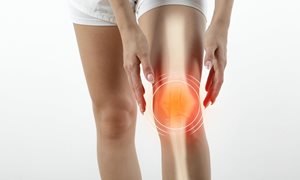5 September 2019
Abstract
The objective of this study was to develop a new calibration method that enables calibration of Hounsfield units (HU) to bone mineral densities (BMD) without the use of a calibration phantom for fracture risk prediction of femurs with metastases using CT-based finite element (FE) models. Fifty-seven advanced cancer patients (67 femurs with bone metastases) were CT scanned atop a separate calibration phantom using a standardized protocol. Non-linear isotropic FE models were constructed based on the phantom calibration and on two phantomless calibration methods: the "air-fat-muscle" and "non-patient-specific" calibration. For air-fat-muscle calibration, peaks for air, fat and muscle tissue were extracted from a histogram of the HU in a standardized region of interest including the patient's right leg and surrounding air. These CT peaks were linearly fitted to reference "BMD" values of the corresponding tissues to obtain a calibration function. For non-patient-specific calibration, an average phantom calibration function was used for all patients. FE failure loads were compared between phantom and phantomless calibrations. There were no differences in failure loads between phantom and air-fat-muscle calibration (p = 0.8), whereas there was a significant difference between phantom and non-patient-specific calibration (p<0.001). Although this study was not designed to investigate this, in four patients who were scanned using an aberrant reconstruction kernel, the effect of the different kernel seemed to be smaller for the air-fat-muscle calibration compared to the non-patient-specific calibration. With the air-fat-muscle calibration, clinical implementation of the FE model as tool for fracture risk assessment will be easier from a practical and financial viewpoint, since FE models can be made using everyday clinical CT scans without the need of concurrent scanning of calibration phantoms.
Publication
Calibration with or without phantom for fracture risk prediction in cancer patients with femoral bone metastases using CT-based finite element models.
Eggermont F, Verdonschot N, van der Linden Y, Tanck E.
Florieke Eggermont and Esther Tanck are members of theme Reconstructive and regeneratice medicine.

Abstract
The objective of this study was to develop a new calibration method that enables calibration of Hounsfield units (HU) to bone mineral densities (BMD) without the use of a calibration phantom for fracture risk prediction of femurs with metastases using CT-based finite element (FE) models. Fifty-seven advanced cancer patients (67 femurs with bone metastases) were CT scanned atop a separate calibration phantom using a standardized protocol. Non-linear isotropic FE models were constructed based on the phantom calibration and on two phantomless calibration methods: the "air-fat-muscle" and "non-patient-specific" calibration. For air-fat-muscle calibration, peaks for air, fat and muscle tissue were extracted from a histogram of the HU in a standardized region of interest including the patient's right leg and surrounding air. These CT peaks were linearly fitted to reference "BMD" values of the corresponding tissues to obtain a calibration function. For non-patient-specific calibration, an average phantom calibration function was used for all patients. FE failure loads were compared between phantom and phantomless calibrations. There were no differences in failure loads between phantom and air-fat-muscle calibration (p = 0.8), whereas there was a significant difference between phantom and non-patient-specific calibration (p<0.001). Although this study was not designed to investigate this, in four patients who were scanned using an aberrant reconstruction kernel, the effect of the different kernel seemed to be smaller for the air-fat-muscle calibration compared to the non-patient-specific calibration. With the air-fat-muscle calibration, clinical implementation of the FE model as tool for fracture risk assessment will be easier from a practical and financial viewpoint, since FE models can be made using everyday clinical CT scans without the need of concurrent scanning of calibration phantoms.
Publication
Calibration with or without phantom for fracture risk prediction in cancer patients with femoral bone metastases using CT-based finite element models.
Eggermont F, Verdonschot N, van der Linden Y, Tanck E.
Florieke Eggermont and Esther Tanck are members of theme Reconstructive and regeneratice medicine.
Related news items

Survey of patients to address knee pain from removed meniscus
19 November 2021 Patients with persistent knee pain after meniscus removal can participate at three locations in the Netherlands in the AIR2 study by ATRO Medical, a spin-off of the Radboudumc and DSM. go to page
ATRO Medical, Radboudumc and Samaplast develop new meniscus prosthesis Consortium receives EUROSTARS grant for innovative project
16 July 2020 An international consortium led by ATRO Medical, a spin-off of Radboudumc and DSM, will receive € 800,000 European funding for an innovation aimed at patients with knee osteoarthritis. These patients often suffer from cartilage wear due to a meniscus that no longer works properly. go to page
€180k for Orthopaedic Research Laboratory
31 January 2019 Researchers of the Orthopaedic Research Laboratory of the Radboudumc, together with the LUMC, received a grant of €180k from the Innovatiefonds Zorgverzekeraars for clinical implementation of patient-specific computer models for fracture risk prediction in patients with bone metastases. go to page
Philip van der Wees appointed Professor of Allied Health Sciences
30 May 2018 The focus of the Chair is value-driven allied health care in interdisciplinary networks. go to page
Honorary doctorate in Aalborg for Nico Verdonschot
25 April 2018 Verdonschot has a global reputation in the field of orthopaedic biomechanics. Besides professor in the Radboudumc, he is the scientific director of the TechMed Centre, and professor of Biomechanical Implants at the department of Biomechanical Engineering at the UT. go to page
